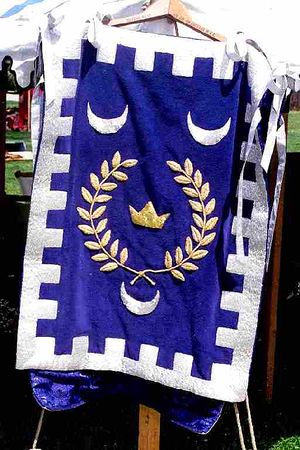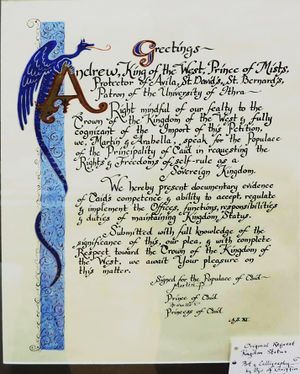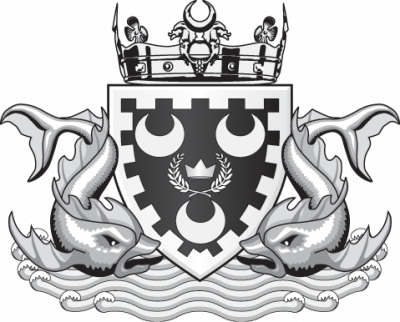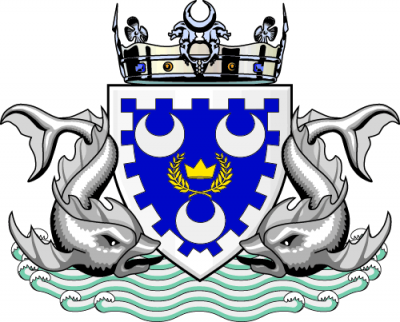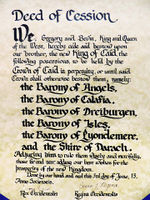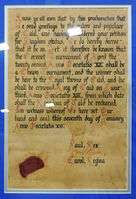Caid: Difference between revisions
m →Combat |
|||
| Line 14: | Line 14: | ||
==A Brief Early History== | ==A Brief Early History== | ||
The [http://www.sca.org/ SCA] actually began in the early 1960s, when David Thewlis (Duke [http://history.westkingdom.org/Who/Who-S.htm#1142 Siegfried von Hoflichskeit]) and Ken de Maiffe (Duke [http://history.westkingdom.org/Who/Who-F.htm#526 Fulk de Wyvern]) met while studying languages at the AFB in Bremerhaven, Germany. Their shared love of the Middle Ages led them to begin studying the art of sword-and-shield fighting. In February 1966, after returning to the U.S., they began practicing combat with wooden swords and plywood shields. The fighting made Diana Paxson (Countess [ | The [http://www.sca.org/ SCA] actually began in the early 1960s, when David Thewlis (Duke [http://history.westkingdom.org/Who/Who-S.htm#1142 Siegfried von Hoflichskeit]) and Ken de Maiffe (Duke [http://history.westkingdom.org/Who/Who-F.htm#526 Fulk de Wyvern]) met while studying languages at the AFB in Bremerhaven, Germany. Their shared love of the Middle Ages led them to begin studying the art of sword-and-shield fighting. In February 1966, after returning to the U.S., they began practicing combat with wooden swords and plywood shields. The fighting made Diana Paxson (Countess [[Diana Listmaker]]), a post-grad medieval history major, recall the fabled "[https://en.wikipedia.org/wiki/Eglinton_Tournament_of_1839 | Last Tournament]," which had been held in Scotland in 1839. | ||
"The Earl of Eglanton, a high-minded young nobleman, complete with castle, serfs, and a head full of the novels of Sir Walter Scott, decided to dramatize the values of the Middle Ages, which were Scott's and his own answer to the problems of the Industrial Revolution, by having a tournament. Costumes were prepared, banners were sewn, and the springs of the London hansom cabs broken by the weight of men in armor being born to practice. It was the social event of the year. The Great Day arrived and the splendid procession processed and the jousting commenced. And then it began to rain ... Do you know what happens to armor in the rain? And banners? And respectable English noblemen without any shelter? That was the end of the Romantic Period in England." (from Diana Paxson's fanzine, <i>Patterns</i>, which gave an account of the first tournament of the SCA.) | "The Earl of Eglanton, a high-minded young nobleman, complete with castle, serfs, and a head full of the novels of Sir Walter Scott, decided to dramatize the values of the Middle Ages, which were Scott's and his own answer to the problems of the Industrial Revolution, by having a tournament. Costumes were prepared, banners were sewn, and the springs of the London hansom cabs broken by the weight of men in armor being born to practice. It was the social event of the year. The Great Day arrived and the splendid procession processed and the jousting commenced. And then it began to rain ... Do you know what happens to armor in the rain? And banners? And respectable English noblemen without any shelter? That was the end of the Romantic Period in England." (from Diana Paxson's fanzine, <i>Patterns</i>, which gave an account of the first tournament of the SCA.) | ||
Revision as of 19:42, 23 August 2022
Caid was the 6th Kingdom created in the Society for Creative Anachronism. A subject of Caid is known as a "Caidan" (rather than "Caidian").
Location
Currently, Caid encompasses the area from south from Merced, CA to the U.S. border with Mexico and west from Las Vegas, NV to Hawai’i.
Originally, the Kingdom of Caid included Southern California, from Bakersfield south to the Mexican border, and east to the Arizona and Nevada borders.
Rieslingshire, the first Shire in the SCA and originally part of the Kingdom of the West, eventually joined Caid; it became the Barony of Nordwache.
New Zealand, which had been part of the Kingdom of the West, also opted to leave the West and become part of Caid. In 2003, it joined the Kingdom of Lochac, which was established in 2002. However, the Barony of Southron Gaard, Shire of Darton, and Shire of Ildhafn show their former allegiance to Caid heraldically in the form of Augmentations of Arms received from the Crown of Caid.
For specific details about the various areas of Caid, see Territories.
A Brief Early History
The SCA actually began in the early 1960s, when David Thewlis (Duke Siegfried von Hoflichskeit) and Ken de Maiffe (Duke Fulk de Wyvern) met while studying languages at the AFB in Bremerhaven, Germany. Their shared love of the Middle Ages led them to begin studying the art of sword-and-shield fighting. In February 1966, after returning to the U.S., they began practicing combat with wooden swords and plywood shields. The fighting made Diana Paxson (Countess Diana Listmaker), a post-grad medieval history major, recall the fabled "| Last Tournament," which had been held in Scotland in 1839.
"The Earl of Eglanton, a high-minded young nobleman, complete with castle, serfs, and a head full of the novels of Sir Walter Scott, decided to dramatize the values of the Middle Ages, which were Scott's and his own answer to the problems of the Industrial Revolution, by having a tournament. Costumes were prepared, banners were sewn, and the springs of the London hansom cabs broken by the weight of men in armor being born to practice. It was the social event of the year. The Great Day arrived and the splendid procession processed and the jousting commenced. And then it began to rain ... Do you know what happens to armor in the rain? And banners? And respectable English noblemen without any shelter? That was the end of the Romantic Period in England." (from Diana Paxson's fanzine, Patterns, which gave an account of the first tournament of the SCA.)
Diana, David, and Ken decided to hold a Medieval-themed going-away party for Diana who was entering the Peace Corps. The event included a "protest march" against the 20th century along Telegraph Avenue. 18 months later, the single event had morphed into regular activities including tournaments, revels, and classes on various arts and sciences. The SCA as we know it was formalized on January 6, 1968 at Twelfth Night and incorporated in July of that year.
SCA participants in Southern California drove up to the Bay area (Berkeley, San Francisco, etc.) to participate in events. Beginning in 1970, events were also held in the local area (which at the time was mostly included in what was then the Barony of the Angels.1 From Angels came Calafia, Isles, and Dreiburgen. The four "Southern Baronies," as they were known, gathered in Dreiburgen on April 20, 1974 for the Royal Tourney of Union 1974, and the Principality of Caid was born, with then-King of the West Andrew of Riga as its first Prince.
Four years later, the formal petition for Kingdom status was presented on January at West Kingdom 12th Night to TRMs Andrew of Riga and Patrice d'Cilla. Caid's first Crown Tournament was held in April 1978, with the first Coronation held on June 6, 1978, at which Armand de Sevigny and Diana de Savigny were crowned King and Queen of Caid by the West's only Caidan King and Queen Gregory of York and Bevin Fraser of Stirling.
Some of the "Firsts" in Caid include:
- 1st Caidans to receive Awards of Arms: Bjo of Griffin & John ap Griffin. Maestra Flavia was the SCA's 1st Chirurgeon, the founder of the Collegium Caidis, and the 1st Caidan to receive two peerages on the same day. She and Baron John created the Kingdom's newsletter, The Crown Prints. Their daughter, Viscountess Lorissa du Griffin was the SCA's youngest princess at age 10.
- Angels is the SCA's 1st Barony (as noted above) and bestowed the SCA's 1st Baronial award, the Order of the Seraphic Star.
- Naess was the SCA's 1st Canton.
- Countess Bevin Fraser of Stirling was Caid's 1st Laurel and 1st Pelican, 1st Principality Seneschal, and the West's 1st (and only) Caidan Queen. She was also Society Steward (03/1978-01/1980).
- The SCA-wide Order of the Rose was founded by Countess Amina de Talavera, then known as Sheryl of Thespis, who ruled as Queen of the West from 01/06/1968-05/05/1968. She is active in both Angels and Altavia.
- 1st Kingdom in the SCA to hold a Make-A-Wish Tournament (Angels Melee Tourney 1990)
- 1st same-gender Baronage: Baron Giles Hill & Barone Giuseppe Francesco da Borgia [1]
- 1st same-gender Royalty: Agrippa III and Dawid, at Caid's 40th Anniversary and Coronation 2018
For more information, visit Caid Timeline.
1Angels is regarded as the first Barony in the SCA. Atenveldt was founded as a Barony in November 1969, but there was no Baron so it was designated a Province, then a Principality, and eventually it became the SCA's 4th Kingdom.
Sources:
- Reminiscences about the founding of the SCA
- Duke Siegfried on the formation of the SCA
- Interview with Siegfried von Höflichskeit Regarding First SCA 12th Night
Caidan Traditions
As of January 2015, Caid has 11 Baronies, 12 Cantons, 5 Colleges, and 5 Shires. (The Baronies of Angels and Lyondemere are sometimes referred to as "Central" or "Downtown" Caid. ) The symbols of the Kingdom are the crescent and dolphin, and the kingdom's colors are azure and argent (blue and silver). While many of our traditions can be traced to the Kingdom of the West, we also have traditions that are uniquely Caidan:
- Potrero War (annual war held in the Spring in Calafia)
- Great Western War (annual war held in October in Wintermist, which has grown into an SCA-wide event)
- Talon Crescent Festival (annual fighting and A&S event held in Starkhafn)
- Royal Recognition of Excellence, a non-armigerous award designated as RRE, and given by the Crown for "deeds or acts that bear recognition outside the regular structure of awards."
- The Laurel Cope, inspired by the Pelican Cope used in Kingdom of Lochac.
- Western Seas is one of the SCA's three Palatine Baronies. The other two are the Palatine Barony of the Far West (in the West, including Pacific Rim, including Japan, South Korea, Guam, and Thailand), and the Palatine Barony of Allyshia (also in the West, encompassing Humboldt County, California).
We have a year-round tournament season, barring the occasional torrential downpour on the mainland. Because Caid doesn't occupy the same massive area as other Kingdoms, it's possible to attend one event every weekend (other than crossing the Pacific to get to Western Seas, or during December when more than one Yule event may be scheduled), often as a day-trip. Over the years, more and more Caidans have traveled to events in other Kingdoms, including Estrella War, Pennsic War, Lilies War, Gulf Wars, and various symposia for Heraldry and Culinary Arts.
The Kingdom has several major events: March Crown Tourney, August Crown Tourney, June Coronation, January Coronation at 12th Night, and Great Western War in October.
Caidan Fashions
As we know, fashion trends aren't exclusive to the "real" world. Various historical periods (and fantasy realms) have influenced preferences in the SCA. In the late 1970s-early 1980s, many ladies sported a comfortable, easy-to-make "Caid morning dress," which was a modified version of an early Italian Renaissance gown with a square-necked un-reinforced bodice, high waist, and split skirt, worn with a full-length chemise. Early Middle Ages and Norman-style garb for women and particularly men has always been a staple of Caidan fashion. Along with European garb, there have always been representations of Greek, Roman, and Asian garb in various levels of authenticity. Contrary to the myth, "Welcome to Caid--now get dressed" is not the Kingdom's motto. This phrase is properly attributed to Baron Giles Hill; however, he never intended it to represent the prevailing attitude.
Since the Millennium, Caid, like its fellow Kingdoms, has seen an increase in Viking Age attire and as of 2015, the trend appears to be going strong. There are, of course, still those who favor late 15th c. Italian Renaissance, Tudor, and Elizabethan garb. As always, if you want help with a particular style, you'll be able to find someone who can help you with it.
Combat
Armored combat includes Individual, Melee and War Combat. Caid is also host to a thriving, active Rapier community. Participants also enjoy Archery (Siege, Combat, and Target), Thrown Weapons, and Unarmored Combat. (And yes, there was a time when Freon cans and carpet were worn as armor but that was long ago and far away. . .)
Heraldry
Caid's Kingdom herald is titled "Crescent Principal Herald" who oversees the work of field, court, protocol, and book heralds in Caid. For more information: Kingdom Herald's Office
Ceremonies
Many of Caid's ceremonies hearken back to its origins in the Kingdom of the West. Countess Bevin Fraser of Stirling wrote a number of the ceremonies still being used, including the one for the Dolphin, which includes the somewhat infamous response of "of Happy Memory" that follows the mention of Viscountess Vivian Aurore de la Mer's name. (See Of Happy Memory)
Visitors are often surprised to see that swearing fealty is part of the Caidan peerage elevation ceremony, which is not the case in several other Kingdoms. For many years, as it was done in the West, Caidan candidates for the peerage were called forward without warning. At the first Coronation Giesele Hildegaard of the Mystic Dragon was called forward from the kitchen, where she was cooking the feast, to receive a Laurel. Over the past decade or so, there has been a trend away from these "stealth" peerages; frequently now candidates are notified in advance and given time to prepare for their elevation with a vigil the evening before their elevation, suitable garb, a procession, and any personalized additions to the ceremony - such as swearing fealty in their persona's native language.
The Kingdom Name
Way back when, people wrote the name of the Kingdom in all capitals: "CAID" as a reference to the acronym for the four founding baronies of Caid: Calafia, Angels, Isles (now a shire), and Dreiburgen. However, this practice was abandoned some time ago, and the Kingdom name should not be spelled in all capitals. In fact, the kingdom's officially-registered name is "Caid," going back to February 1975.
In awards and ceremonies, "Caidis," which means "of Caid" in Latin (genitive), is used. For example, "Regina Caidis" (Queen of Caid), "Collegium Caidis" and, of course, "Compendium Caidis."
For more reading about the kingdom name:
Royal Arms
The Kingdom has several coats of arms registered for the use of the King, Queen, Prince and Princess.
| Description | Image Preview |
|---|---|
| The arms of the Kingdom of Caid, Azure, a crown within a laurel wreath Or, between three crescents within a bordure embattled argent may be displayed to indicate the presence of the King or both the King and Queen together. | 
|
| The presence of the Queen may be indicated either by display of the Queen's arms*, Azure, a rose Or between three crescents within a bordure embattled argent, or display of the arms of the Kingdom of Caid. |  
|
| The presence of al-Caid, the Crown Prince of Caid, may be indicated either by display of the Prince's arms*, Argent, three crescents and on a chief azure a dolphin embowed argent, or by display of the kingdom arms differenced by a gold label, indicating status as heir to those arms. | 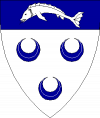 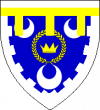
|
| The presence of Lady Caid, the Crown Princess of Caid, may be indicated either by display of the Princess' arms*, Argent, three crescents and on a chief azure a rose Or, or by display of either the Kingdom arms or the Queen's arms differenced by a gold label. | 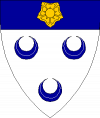  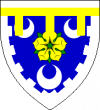
|
*After July 2004, the College of Arms of the SCA no longer registers arms for a kingdom or principality's consort or heirs. The arms for Caid's consort and heirs were registered prior to that date, and therefore may continue to be used. If the Queen chooses, she may display the kingdom arms instead, which is closer to period practice, and helps indicate that the King and Queen are coequal. Likewise, the Crown Prince and Princess may choose to display the kingdom arms differenced by a gold label, to indicate their status as heirs to the Kingdom.
Additional Artwork
Populace Badge

|
The kingdom has registered "Azure, four crescents conjoined in saltire horns outward argent" for the use of the populace. This badge is more commonly referred to as the "Cross of Caid" or "Caidan Cross". It may be displayed by any Caidan on flags, clothing, etc. to show allegiance to the kingdom. It may be displayed on a blue field, or the crescents alone may be displayed as a "fieldless" badge. | 
|
Royalty
See Royals for a full list of Royalty.
Territorial Barons and Baronesses
See Baronage for a full list of Territorial Barons and Baronesses.
Peerage
Caid welcomes Peers who were elevated in other Kingdoms.
Awards
See Awards for a full list of Caidan awards.
Trivia
- Caid - (Arabic: qāʾid "commander"), also spelled kaid or caïd, means "master" or "leader." It was a title in the Norman kingdom of Sicily, applied to palatine officials and members of the curia. Later the word was used in North Africa for the governor of a fortress or the warden of a prison, and also in Spain and Portugal in the form with the definite article, al-cayde. The title alcalde was used to refer to the mayor of Spanish towns.1
- Established: June 8, 1974 A.S. IX as a principality of the West.
- Became a Kingdom: June 3, 1978 A.S. XIII.
- The Crown Prince is known as "al-Caid." (As a point of interest, the last star on the handle of the Big Dipper is named al-Caid.)
- The Crown Princess briefly had the unwieldy alternate title of "al-Caidessa" but is now referred to as "Lady Caid."
- The name has no affiliation with Irish football or the Cumann Ceilteach Rince Gaelach.
- Since Wintermist was elevated from shire to Barony, there are four shires in Caid: Carregwen, al-Sahid, Isles, and Darach, whose initials just so happen to spell CAID.
1 http://en.wiktionary.org/wiki/caid, http://en.wiktionary.org/wiki/alcaide#Spanish, and http://en.wikipedia.org/wiki/Alcalde
From time to time, Caidans living in other parts of the world have "claimed" areas on behalf of the Kingdom:
- In 1999, Brazil (Rio de Janeiro) was claimed as a "territory."
- Baron Cameron of Caladoon was granted a portion of a highway meridian so that he could call himself a "landed" Baron.
Gallery
-
Deed of Cession
-
Grant of Kingdom Status
More Information
| Territories |
|---|
| Caidan Baronies: Altavia, Angels, Calafia, Dreiburgen, Dun Or, Gyldenholt, Lyondemere, Naevehjem, Nordwache, Starkhafn, Western Seas, Wintermist Caidan Shires: Al-Sahid, Carreg Wen, Darach, Isles Caidan Cantons: Bard's Keep, Canyons, Castle North, Cragdon, Gallavally, Mons Draconis, Peridot Isle, Poll na Gainmhe, Steinsee, Summergate, Tanwayour, Torvald, Valley Azure Caidan Colleges: Boethius, Fenwood Knoll, Noe, Saint Artemas, Saint Firmin, San Ambrogio, San Isidore, Tour d'Yvoire, Voyagers Other Information: Former Territories, Kingdoms, Known World |
